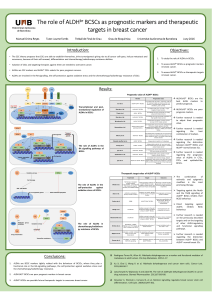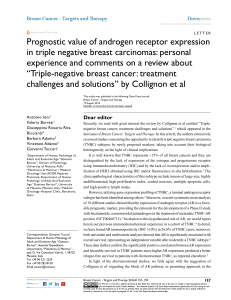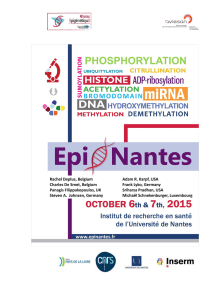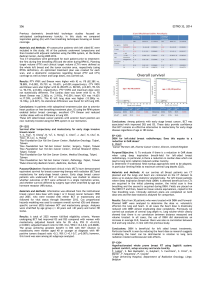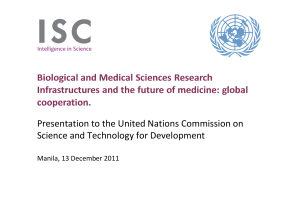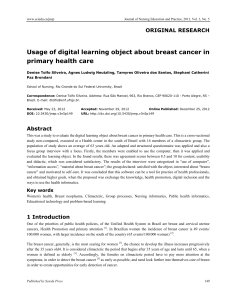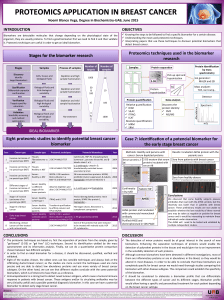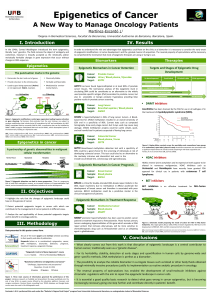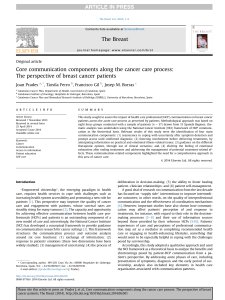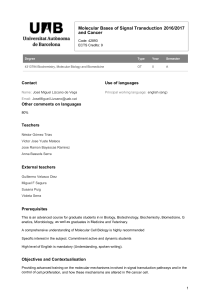2016/2017 Cancer and Radiobiology Use of languages Contact
publicité
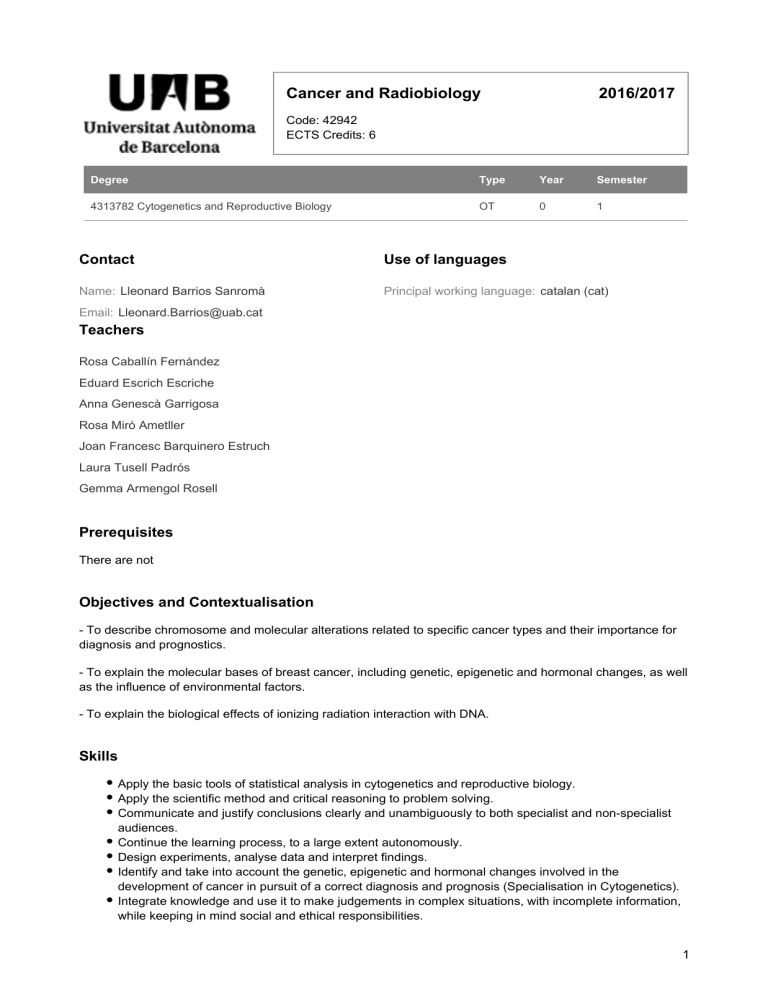
Cancer and Radiobiology 2016/2017 Code: 42942 ECTS Credits: 6 Degree Type Year Semester 4313782 Cytogenetics and Reproductive Biology OT 0 1 Contact Use of languages Name: Lleonard Barrios Sanromà Principal working language: catalan (cat) Email: [email protected] Teachers Rosa Caballín Fernández Eduard Escrich Escriche Anna Genescà Garrigosa Rosa Miró Ametller Joan Francesc Barquinero Estruch Laura Tusell Padrós Gemma Armengol Rosell Prerequisites There are not Objectives and Contextualisation - To describe chromosome and molecular alterations related to specific cancer types and their importance for diagnosis and prognostics. - To explain the molecular bases of breast cancer, including genetic, epigenetic and hormonal changes, as well as the influence of environmental factors. - To explain the biological effects of ionizing radiation interaction with DNA. Skills Apply the basic tools of statistical analysis in cytogenetics and reproductive biology. Apply the scientific method and critical reasoning to problem solving. Communicate and justify conclusions clearly and unambiguously to both specialist and non-specialist audiences. Continue the learning process, to a large extent autonomously. Design experiments, analyse data and interpret findings. Identify and take into account the genetic, epigenetic and hormonal changes involved in the development of cancer in pursuit of a correct diagnosis and prognosis (Specialisation in Cytogenetics). Integrate knowledge and use it to make judgements in complex situations, with incomplete information, while keeping in mind social and ethical responsibilities. Interpret, resolve and report on clinical cases or scientific findings in the area of the master's degree. 1 Interpret, resolve and report on clinical cases or scientific findings in the area of the master's degree. Solve problems in new or little-known situations within broader (or multidisciplinary) contexts related to the field of study. Use acquired knowledge as a basis for originality in the application of ideas, often in a research context. Use and manage bibliography or ICT resources in the master's programme, in one's first language and in English. Use creative, organisational and analytic skills when taking decisions. Learning outcomes 1. Apply the scientific method and critical reasoning to problem solving. 2. Communicate and justify conclusions clearly and unambiguously to both specialist and non-specialist audiences. 3. Continue the learning process, to a large extent autonomously. 4. Describe the importance of chromosomal and molecule alterations in the diagnosis of certain cancers and their prognosis factor. 5. Design experiments, analyse data and interpret findings. 6. Explain the biological effects of the interaction of ionising radiations with DNA. 7. Integrate knowledge and use it to make judgements in complex situations, with incomplete information, while keeping in mind social and ethical responsibilities. 8. Solve problems in new or little-known situations within broader (or multidisciplinary) contexts related to the field of study. 9. Use acquired knowledge as a basis for originality in the application of ideas, often in a research context. 10. Use and manage bibliography or ICT resources in the master's programme, in one's first language and in English. 11. Use creative, organisational and analytic skills when taking decisions. 12. Use statistical methods to estimate, through biological methods, the dose of exposure to ionising radiation. 13. Write articles or report scientific findings in the area of cancer or radiobiology. Content Lesson 1: Genetics of cancer The unstable genome of a tumoral cell, telomeric dysfunction and chromosome instability. Genetics of haematological diseases. Acute leukaemia, the example of acute lymphoblastic leukaemia. Chronic leukaemia, the example of chronic lymphocytic leukaemia. Genetics of mesenchymal and epithelial solid tumours. Colon cancer as a model. Methodologies for genome analyses, transcriptome and methylome of the tumoral cell. Lesson 2: Molecular mechanisms of breast cancer Molecular mechanisms of cancer. The example of breast cancer. Embryology and functional morphology of the normal breast and morphologic changes in breast cancer. Physiology of the normal mammary gland and physiopathology of breast cancer. Genetic and epigenetic factors. Endocrine factors and mechanisms of hormonal action. Environmental factors and life style. Clinical basis of breast pathology, metastasis. Biological factors for prognosis. Heritable breast cancer and prevention. Lesson 3: Radiobiology Introduction to ionising radiations and radioprotection. Induced DNA lesions and repair mechanisms. Radioinduced chromosome aberrations. Biological dosimetry (aberrations, methods of analysis, dose-effect curves, partial exposures). Radioprotectors and chromosome sensitivity. Telomeres, repair and radiosensitivity. Effects of low-dose exposures. Methodology Teaching methodology will include: 2 1.- Master classes 2.- Discussion of research papers previously read 3.- Homework presentation Activities Title Hours ECTS Learning outcomes 42 1.68 1, 4, 6, 8, 7, 9, 10 15 0.6 1, 5, 11, 13, 2, 7, 3, 10, 12 82 3.28 7, 3, 10 Type: Directed Master classes Type: Supervised Homework presentation and scientific articles discussion Type: Autonomous Scientific papers reading and study Evaluation The course consists in three lessons with a weight, in time, of about 40% for lessons 1 and 2 and 20% for lesson 3. This weight will be maintained for the establishment of the final score. Lesson 1 will be scored by an exam (35% of the final score), and lessons 2 and 3 by discussion of papers and homework presentation (55%). Finally, attending and active participation will represent a 10% of the final score. Evaluation activities Title Weighting Hours ECTS Learning outcomes Attendance and active participation 10% 3 0.12 1, 4, 5, 6, 11, 13, 8, 2, 7, 3, 9, 10, 12 Examination 35% 4 0.16 4, 6, 8, 2, 9, 10 Homework presentation 55% 4 0.16 1, 4, 5, 6, 11, 13, 8, 2, 7, 3, 9, 10, 12 Bibliography - Crasta K, Ganem NJ, Dagher R, Lantermann AB, Ivanova EV, Pan Y, Nezi L, Protopopov A, Chowdhury D, Pellman D. DNA breaks and chromosome pulverization from errors in mitosis. Nature. 2012 Jan 18;482(7383):53-8. - Croce CM (2008). Molecular origins of cancer: Oncogenes and cancer. N Engl J Med. 358(5):502-11. - Chiang AC, Massagué J (2008). Molecular basis of metastasis. N Engl J Med. 359(26):2814-23. - Cytogenetic Dosimetry. Applications in preparedness for and response to radiation emergencies. EPR-Biodosimetry. IAEA, Vienna 2011. - DePinho RA. The age of cancer. Nature. 2000 Nov 9;408(6809):248-54. - Sharma S, Kelly TK, Jones PA (2009). Epigenetics in Cancer. Carcinogenesis. 2009 Sep 13. 3 - Stingl J, Caldas C (2007). Molecular heterogeneity of breast carcinomas and the cancer stem cell hypothesis. Nat Rev Cancer. 7(10):791-9. - Russo IH, Russo J (1998). Role of hormones in mammary cancer initiation and progression. J MammaryGland Biol Neoplasia. 3(1):49-61. - Escrich E, Solanas M, Moral R (2006). Olive oil, and other dietary lipids, in cancer: experimental approaches In Quiles JL, Ramirez-Tortosa MC, Yaqoob P (eds.) Olive Oil and Health. CAB International, Oxfordshire, pp.317-374. - Cory SJ et al (2007). Myelodisplastic syndromes: the complexity of stem-cell diseases. Nature Reviews Cancer 7:118-128. - Heim S and Mitelman F. Cancer Cytogenetics. Wiley-Blackwell, New Jersey, USA (2009). - Krivtsov AV et al (2007).MLL translocation, histone modifications and leukemia stem-cell development. Nature Reviews Cancer7:823-833. - Melo JV & Barnes DJ. (2007). Chronic myeloid leukaemia as a model of disease evolution in human cancer. Nature Reviews Cancer 7:441-453. - Mitelman et al (2007). The impact of translocations and gene fusions on cancer causation. Nature Reviews Cancer 7:233-245. - Mullighan CG etal (2007). Genome-wide analysis of genetic alterations in acute lymphoblastic leukemia Nature446:758-764. - Nergadze SG, Santagostino MA, Salzano A, Mondello C, Giulotto E. Contribution of telomerase RNA retrotranscription to DNA double-strand break repair during mammalian genome evolution. Genome Biol. 2007;8(12):R260. - Pui CH (ed). Chilhood Leukemias. Cambridge University Press, Cambridge, UK (2006). - Stallings RL (2007). Are chromosomal imbalances important in cancer? Trend in Genetics 23(6):278-293. - Radiobiology for the radiologist. E.J. Hall i A.J. Giaccia. Ed. Lippincott Williams & Wilkins. Sixth Edition, 2006. - Sachs R & Brenner D.Chromosome aberrations produced by ionizing radiation: Quantitative studies. NCBI books. http://web.ncbi.nlm.nih.gov/books/bv.fcgi?rid=mono_002 - Sedelnikova OA, Horikawa I, Redon C, Nakamura A, Zimonjic DB, Popescu NC, Bonner WM. Delayed kinetics of DNA double-strand break processing in normal and pathological aging. Aging Cell. 2008 Jan;7(1):89-100. 4












